#Pavillon Richelieu
Explore tagged Tumblr posts
Text
Louvre Museum 🏛️


#Louvre#Museum#Window#Architecture#Cloudy Sky#Pavillon Richelieu#Louvre Museum#Louvre Palace#French Moments#Paris#France
128 notes
·
View notes
Text






Le Louvre de Jean-Christophe Ballot (né en 1960)
Pavillon Sully, Cour Carrée, la salle des Cariatides
Aile Denon, la Victoire de Samothrace
Statue II
Aile Denon, Les noces de Cana de Véronèse
Aile Sully, Cour carrée, la galerie Henri IV
Aile Richelieu, Ll'escalier Hector Lefuel
#Pavillon Sully#Cour Carree#Ballot#Sully#Richelieu#Denon#Véronèse#louvre#musée du Louvre#Paris#photo#photographie
8 notes
·
View notes
Text
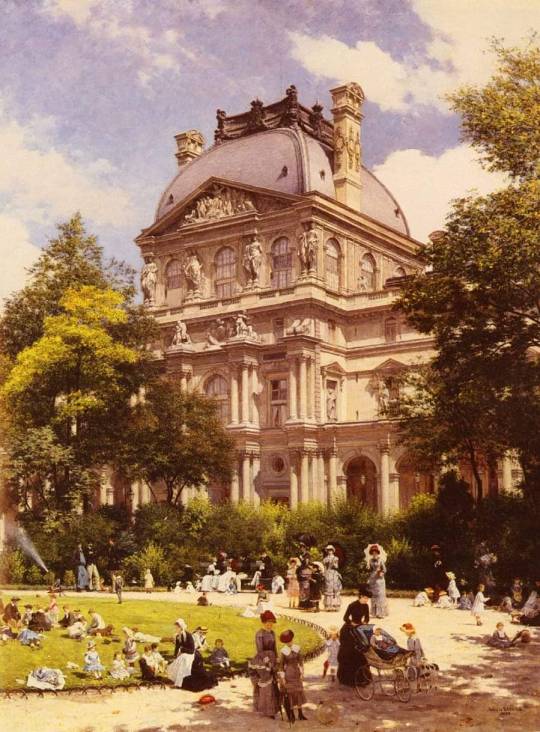
Louis Béroud.
Les jardins du Carrousel et le pavillon Richelieu
1883. Paris Painting France
2 notes
·
View notes
Photo

Un autre jour de juin…
Le passage sous le pavillon Richelieu voit des milliers de touristes passer de la rue de Rivoli à la cour Napoléon. Il est sombre, avec à certaines heures des reflets de lumière renvoyés par la petite pyramide qui cherche ainsi à se singulariser de sa grande sœur qui semble glaner toutes les attentions des visiteurs.
Un homme joue avec virtuosité du violon. Il est accompagné par une musique de Bach aussi pure que l’eau d’une source qui s’écoule, éternelle. Ensemble ils métamorphosent ce sombre passage en une salle de concert lumineuse dans un des plus beaux lieux au monde.
Ma ballade se transforme au gré des lieux, des lumières, des hommes, des femmes croisés sur mon chemin.
6 notes
·
View notes
Photo

The Pavillon Richelieu of the Louvre, Paris
#Architecture#design#decorative arts#ornament#sculpture#palace#residence#museum#louvre#Paris#beaux arts#paris architecture#paris history#france#richelieu
152 notes
·
View notes
Photo

Quand le pavillon Richelieu se reflète sur la Pyramide du Louvre.
0 notes
Text
Marie de Médicis : la reine déchue
Bien le bonjour ! Je vous retrouve aujourd’hui pour ce troisième et dernier article dédié à Marie de Médicis.

Comme nous l’avons vu dans l’article précédent, la régence de Marie de Médicis vient de toucher à sa fin. Louis XIII entre dans sa quatorzième année, la majorité royale, et il est donc normalement prêt à régner. J’insiste sur le normalement car les choses ne vont pas se dérouler si simplement.
En effet Marie de Médicis ne considère pas son fils comme apte à prendre le relais. Louis XIII ne semble pas s’intéresser au Conseil, bien qu’il y assiste par obligation. Il est taciturne, introverti, bègue... Bref, il ne correspond pas aux attentes de sa royale maman qui va donc prendre la tête du Conseil pour continuer de s’occuper des affaires d’état.
La différence étant qu’en tant que chef du Conseil, Marie de Médicis n’a plus à se tenir à l’ancienne politique d’Henri IV comme elle le devait durant la régence. Ayant prit goût au pouvoir, elle change complètement le gouvernement, désigne Richelieu aux Affaires étrangères, et fait accéder Concino Concini (et oui, il est toujours là) à un rôle politique gouvernemental de première importance puisqu’il doit protéger et gérer cette nouvelle équipe.
Mais Marie est une femme (ah oui, l’égalité homme/femme au XVIe siècle c’est pas fou), et bien qu’elle détienne toujours son titre de reine, elle n’est pas censée avoir le pouvoir de tout remanier comme bon lui semble. Les Grands (la noblesse) se révoltent, dénoncent la mauvaise influence du conseiller italien et vont trouver un allié en la personne... de Louis XIII. Car le jeune roi se sent humilié par sa mère, qui monopolise le pouvoir ; sa relation avec elle a toujours été compliquée et Marie de Médicis n’a jamais caché sa préférence pour le frère de Louis, Gaston d’Orléans, qui a hérité de son raffinement mais aussi de son inconstance. De plus Louis XIII déteste Concini, qu’il considère comme une tutelle encombrante.
Le jeune roi va donc dans le plus grand secret organiser avec l’aide du duc de Luynes, son plus proche ami, la chute du favori italien. Le 24 avril 1617, Concini est arrêté au Louvre. Il tente vainement de résister, d’après les conspirateurs, qui vont alors l’exécuter : trois balles dans le visage et la gorge, les gardes l’achèveront à coups d’épée. Louis XIII aurait alors déclaré “A cette heure, je suis Roi”. Il en profite pour faire exécuter Léonora Galigaï, l’accusant de sorcellerie (ça marche à tous les coups il paraît), il exile la reine-mère au château de Blois, et prend enfin le pouvoir.
Celle-ci vit très mal cet affront et ne conçoit pas d’être mise à l’écart par son propre fils. Néanmoins elle décide d’aménager ce château, y fait construire un pavillon (qui n’existe plus aujourd’hui) par Salomon de Brosse, celui-là même qui construira un peu plus tard le palais du Luxembourg à Paris. Pas question pour elle de réduire son train de vie.
Le 22 février 1619, grâce à une échelle posée contre une fenêtre, Marie de Médicis s’échappe du château de Blois. Elle a cousu à l’intérieur de sa robe ses nombreux bijoux. Avec l’aide de quelques personnes dont sa servante, elle parvient tant bien que mal jusqu’à la terrasse où, avec l’aide d’une corde, elle va descendre aux pieds du château 40 mètres plus bas puis rejoindre un carrosse. Une évasion digne d’un roman !

(Marie de Médicis s’échappant de Blois en toute discrétion)
Elle prend alors la tête du parti des malcontents et des nobles contre qui elle s’était si longtemps opposée durant la régence et va tout de même être à l’origine de deux petites guerres civiles (qu’elle perdra) qui prendront le nom de “guerres de la mère et du fils”.
Louis XIII comprend alors que la seule façon d’arrêter ces conflits est de réintroduire Marie de Médicis à la cour de France et au Conseil du Roi. Et cette réconciliation est en partie dû à un certain Richelieu, qui a su apaiser les tensions familiales. Marie revient donc à Paris accompagnée du Cardinal de Richelieu et lui fait également intégrer le Conseil le 29 avril 1624, malgré les réticences de Louis XIII qui se souvient de l’ancien ministre de sa mère.
En parallèle, elle termine la construction du fameux palais du Luxembourg, où siège aujourd’hui le Sénat, et s’y installe en 1625. Elle offre d’ailleurs le petit Luxembourg au Cardinal en 1627.

(Palais du Luxembourg à Paris)
Mais Marie se rend très vite compte qu’elle n’a plus l’influence d’antan sur son fils, que ses conseils ne sont plus écoutés et que Louis XIII s’est beaucoup rapproché de Richelieu avec qui il partage les mêmes opinions politiques, notamment affirmer l’autorité royale (ce qui donnera par la suite les prémices de la monarchie absolue).
Se sentant exclue face à ce nouveau binôme, redoutant la puissance de Richelieu qui a su se faire une place auprès du roi à ses dépends, la reine-mère décide de passer à l’action. Le 12 novembre 1630, elle convoque son fils au Palais du Luxembourg où elle ordonne que personne ne viennent les déranger. Marie de Médicis va alors demander à Louis XIII la destitution de Richelieu. Malheureusement pour elle, le roi décide de garder auprès de lui son précieux ministre.
Marie, trahit par cet homme qu’elle avait placé elle-même près de son fils, quitte la cour de France et va s’exiler au château de Compiègne. Elle tentera par la suite de monter de nouveaux complots (une fâcheuse habitude visiblement), plaidant sa cause à Bruxelles, ce qui lui vaudra de perdre son statut de reine de France et donc ses pensions. Se faisant balloter entre les différentes cours d’Europe, en Angleterre mais également en Allemagne, sans jamais pouvoir retourner en France.
Malade, elle se réfugie dans la maison de son ami peintre Pierre-Paul Rubens à Cologne. Très loin du faste et du confort de son Palais du Luxembourg, exilée et seule, Marie de Médicis s’éteindra le 3 juillet 1642 à l’âge de 67 ans. Son corps sera ramené à Saint-Denis et Louis XIII interdira en France toute cérémonie en l’honneur de sa mère.
Louis XIII décédera quelques mois après sa mère, laissant la place à un nouveau roi qui n’a alors que quatre ans : Louis XIV.
Une nouvelle régence, une nouvelle femme : Anne d’Autriche

Alors OUI JE SAIS, je vous vois venir, ce n’est pas une fin très glorieuse. Mais en regardant le parcours de cette femme dans sa globalité, on remarque sa force de caractère, et surtout son ambition à toutes épreuves. Car elle n’a cessé de se battre pour obtenir gain de cause : contre son mari Henri IV d’abord, qui ne souhaitait pas la faire couronner. Contre les aristocrates et les princes du sang pendant la régence, préservant la couronne pour son fils. Puis contre son fils lui même, ne le croyant pas capable de gouverner ce pays dont elle était devenue reine et dans lequel elle ne sera jamais réellement acceptée.
J’espère sincèrement que ce sujet vous aura plu, n’hésitez pas à me faire des retours sur ces premiers articles, à poser des questions si vous en avez, et je vous retrouve bientôt pour un sujet complètement différent !
Bonne soirée,
L’escadron guidant
Bio : https://www.histoire-pour-tous.fr/histoire-de-france/1550-louis-xiii-le-juste-roi-de-france-1601-1643.html https://www.lhistoire.fr/le-roi-est-mort-vive-la-r%C3%A9gente https://www.linternaute.fr/actualite/biographie/1776094-cardinal-de-richelieu-mousquetaires-la-rochelle-la-vraie-biographie-du-ministre-de-louis-xiii/
3 notes
·
View notes
Photo

Pavillon Richelieu, Louvre, Édouard Baldus, 1855–56
albumen print
#photography#vintage#vintage photography#edouard baldus#1850s#louvre#paris#france#albumen print#french#sepia
73 notes
·
View notes
Text
Louvre, Paris. ꒷︶🏛️︶꒷

#Louvre Museum#Renaissance#Architecture#Louvre Pyramid#Napoleon Courtyard#I. M. Pei#Pyramids#Pavillon Richelieu#Pavillon Colbert#Cloudy Sky#Louvre Palace#French Moments#Louvre#Museum#Paris#France
106 notes
·
View notes
Text
The Louvre and Eiffel Tower
28/04/2018: An early rise today for at least one person while the rest took it easy. The purpose was to take a walk through Jardin des Tuileries while the crowds weren't around. It was well worth the effort to be able to move around with plenty of room. After the walk, it was briefly back to the room and out again along Rue Saint-Honoré for croissants and pastries. Returning for breakfast we were then all on the move to Paris City Vision, also known as Get Your Guide to collect the Skip the Line tickets to the Louvre.

Allée Centrale, Jardin des Tuileries
We were in the queue at around nine fifteen, waiting to go through the Pyramid entrance security and down to Napoléon Hall, directly beneath the large glass pyramid. Today Shane made the choice of sticking with the girls and Tom and Beau heading off on a brother adventure. This was a wise move as the girls were always left behind as Cecilia wasn’t use to keeping up with the pace set by Shane and therefore the girls walked slower than the boys and were always left far behind. Sadly, we were to discover the reason for Cecilia’s struggle to keep up a few months after returning to Australia. Anyway, this separation between the men and women folk were making the girls feel like it was an “us and them” holiday when out exploring. So good boy Shane for keeping with the women today. We immediately grabbed a few maps and headed to the Sully Wing, via the ticket box and more security, where the some of the original fortress still stands. Last time it was closed for a reno. Also, the last time we were here, we were guided by Violetta, a masters student in French art and since that was what she was familiar with, that’s what we looked at. By the time we were finished the tour and were able to wander around at will, we were knackered. This time we were on a mission to see whatever else was around, but in particular, the Egyptian stuff.

The Foyer under the Glass Pyramid. Leading to all wings
First impressions were great. As we entered the basement of the Sully Wing, we were drawn to the start of the Pavillon de d'Horloge devoted to the history of the museum and its collections including the original fortress of which plenty still remains today.

Relationship of the original fortress within the Louvre
The path led around the base of what remained of the fortress and included a walkway so that we could walk within the original moat.
Prior to his departure on crusade in 1190, Philip II (King Philippe Auguste), son of Louis VII, erected a fortified enclosure to protect Paris against the threat of invaders while he was away. Ordering the construction of a great wall around the city, he reinforced it at the junction with the Seine by building a defensive fortress. Square in plan with corner towers and an imposing central keep. The Seine fed a moat that encompassed the entire structure with another moat surrounding the keep. Two gates, flanked by towers, were built within the wall, one facing south towards the Seine and the other facing east, leading to the city. As Paris spread west, the castle lost its defensive effectiveness and was later transformed into a luxurious royal residence by King Charles V.
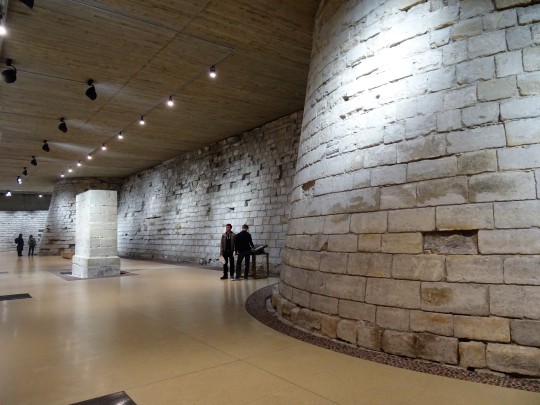
The outer wall of the fortress (and probably the outer moat)

The inner moat and the keep
The path skirted the outer moat and to the far side of the ruins, past the Crypt of the Sphinx and to a long staircase that climbed to the floor above. Halfway up we had a choice, left or right. We chose the right and ended up in the Greek, Etruscan and Roman Antiquities Rooms, which were shared by the Sully and Denon Wings and were welcomed by Athena, a three metre high antique replica of the original bronze from around 430BC.

Great Sphinx of Tanis. "Found" a couple of hundred years ago in the ruins of the Temple of Amun at Tanis (the capital of Egypt during the 21st and 22nd dynasties

Hello! (La Pallas de Velletri)
With Athena behind us, we entered a large room which was full of artefacts from the Greek, or Roman copies of long lost Greek bronzes going back several hundred centuries BC. Bigger than life (they're gods so they should be) statues of Ares, Aphrodites, Zeus, Hermes and such were scattered throughout with smaller, mantle size pieces around the peripheral and reliefs and friezes on the walls.

Aphrodite ("Venus Genitrix")
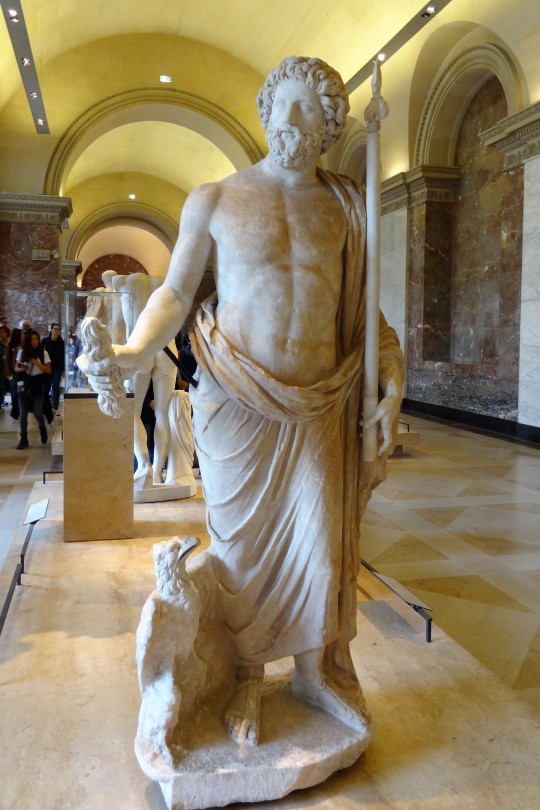
Zeus, dieu des cieux et maître de l’Olympe
The entire display covered the whole Mediterranean basin from the sixth century AD back to Neolithic times. At the end of the Greek section Venus de Milo, demanding her own room ferried us through to the Etruscan and Roman sections.
Doing an about face, we retraced our steps to the central stairs, descended to the landing, back up to the Egyptian Antiquities section and further to the Near Eastern area in the Richelieu Wing, dominated by Iran and Mesopotamia.
Small alcoves were lined with small figurines of Egyptian history. The larger areas were divided by displays of the same, thereby creating more small alcoves. Almost all of the displays were protected in glass. Interesting stuff, jewellery, trinkets, decorative objects, toys and what seemed like kitchen accessories.

Statue du dieu Horus, worshipped from at least the late prehistoric Egypt until the Ptolemaic Kingdom and Roman Egypt, he was one of the most significant ancient Egyptian deities

Partial sarcophagus lid
The row of sphinxes nearby was interesting, a half a dozen were impressive enough, but apparently several hundred of them lined the processional way to the Serapeum in Saqqara, which has long since gone. An 1850's tomb raider noticed these at various antique shops around town and put two and two together. It was apparent that some of the sphinxes came from the same place so he went out and found the place, thereby finding all of the sphinxes, buried in sand.
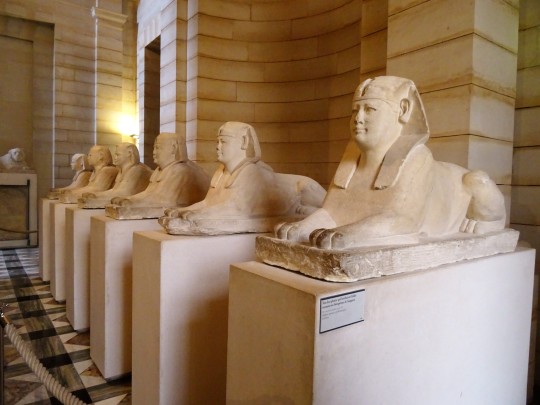
Six des sphinx qui bordaient l'allée menant au Sérapéum de Saqqara
We then came across the mummy sarcophagi, quite a few mainly protected by glass cabinets. Amongst them all was an actual mummy, a well preserved specimen of a male that lived during the Ptolemaic Period. After death and during the mummification process, he was covered in strips of linen and after receiving more attention to dry him out a bit, was covered in cartonnage which consisted of a mask covering his head, a wide collar over his chest, an apron across his legs and a casing over the feet.
This was one of the highlights of the day, probably for everyone as it was difficult to get close to him.

Momie recouverte de ses "cartonnages". Mummy covered with its "Cartonnages ". Embalming jars as well
As the Egyptian section finished, the Near Eastern Antiquities started. The Levant was an area located at the western extreme of the Mediterranean but not too far inland. It seemed to encompass modern day Syria, Jordan, down to what is now the Suez Canal and all between. The sarcophagus of Eshmunazar II, King of Sidon was carved around 500BC for a king whose demise was ahead of his time (he died when 14 years old and ruled the kingdom with his mother). Sidon was located in Phoenicia, now Lebanon and later expanded its horizons by being given lands by the Persian "Lord of Kings", Xerxes as reward by providing their naval fleet to the Persian forces.
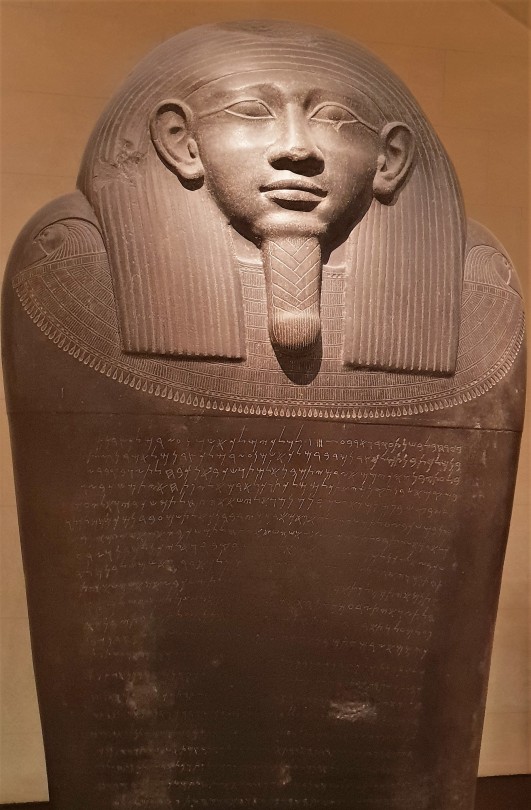
The epitaph across the chest and around the head describes a king who died young and curses on anyone who should trouble his rest among the Rephaïm, followed by a genealogy of the royal family, concluding with a final curse on those who would "raise my slab" and remove the sarcophagus.
The next section was Iran followed by Mesopotamia. There was some great stuff here, the highlights being some friezes from the Persian King Darius I back around 500BC. The first was of lions made of a glazed brick and came from Mesopotamia. They were displayed in his Susa palace and was a symbol of power, embodying the king of beasts. The next frieze was not so certain as to its origins. They were the Archers on Parade depicting two symmetrical lines of soldiers, bow and quiver around their shoulders, both hands holding their spears. Very impressive and quite colourful.
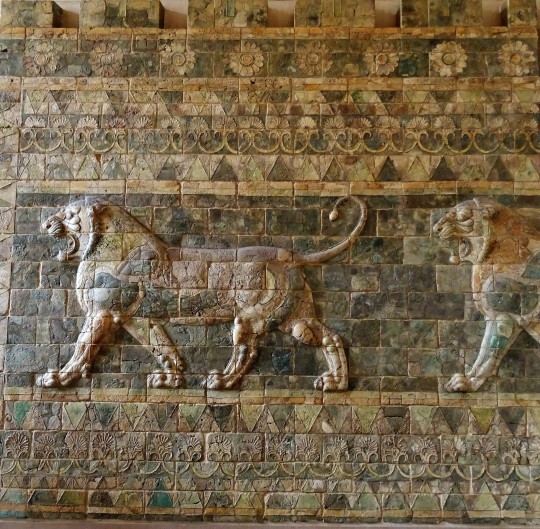
The Frieze of Lions from the first court of Darius I’s palace at Susa

Archers on Parade
Although there was other great stuff in this area, the other impressive artefact was the temple headstock and column (or the colossal capital), one of thirty six that once held up the roof components of the apadana at Susa. A couple of bulls kneeling back to back atop of Egyptian style palm fronds and double volutes with rosettes taken from the temple of Artemis at Ephesus. There wasn't too much in one piece when excavators excavated during the late nineteenth century which explained the colour difference (veined grey limestone brought to the plain of Susa from the Zagros Mountains) due to the capital being reconstructed from bits and pieces of the thirty six columns that originally existed.
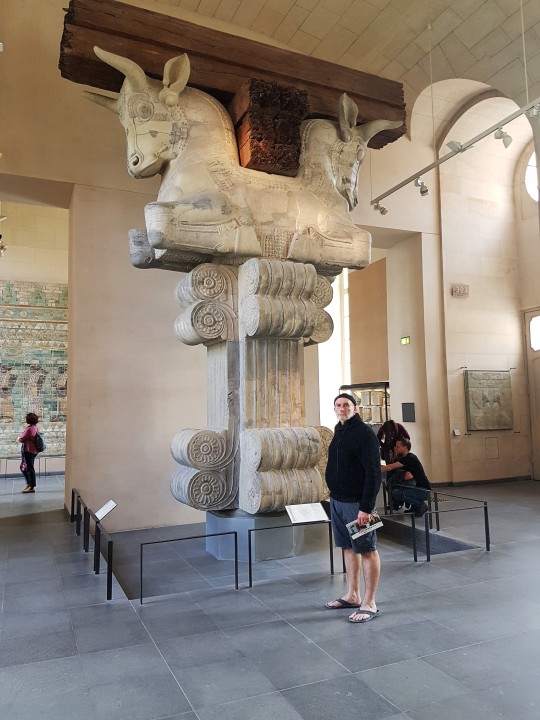
Chapiteau d'une colonne de la salle d'audiences (Apadana) du Palais de Darius Ier
The final part, after a break at the café overlooking Napoléon Hall, was back to the Denon Wing to finish off with a few more statues and some paintings, particularly looking forward to the pushing and shoving in front of the Mona Lisa. After ascending a rather grand staircase we found ourselves on the ground floor amongst the European sculptures before climbing one more floor to the paintings of France, Italy and Spain. One of the final acts of the morning, after wandering through the corridors of religious art was to enter Room 711 where the incredibly underwhelming Mona Lisa proudly hung.

First break for the day.

Andrea di Bartolo dit Solario. La Crucifixion
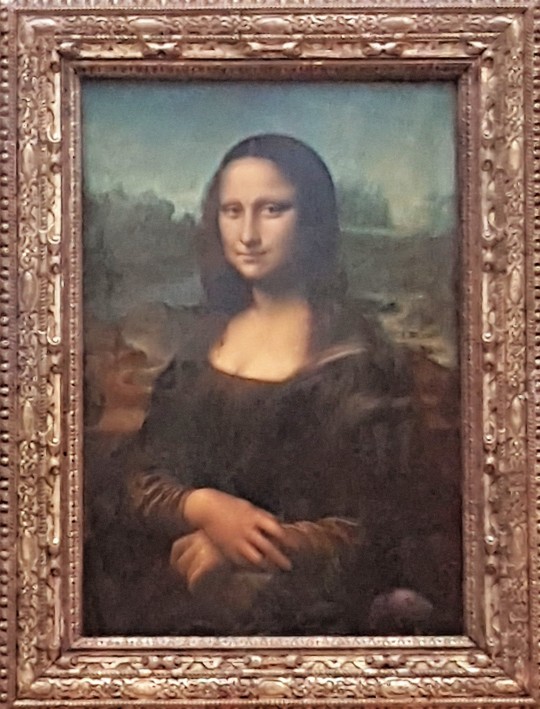
There she is
That was it. Louvre over and lunch ahead, followed by the tower. Playing it safe, we headed back to where we knew, via the Carrousel du Louvre underground shopping centre, eventually reaching the surface at Arc de Triompe du Carrousel, watched a weirdo pigeon man walking around dropping wheat out of his pockets and braved the irksome Africans and gypsies trying to con us or flog us something. Once through the cordon of conmen we settled in at the Le Carrousel Bar and Brasserie for pizza and snails.

Cordon of conmen

Snails for lunch
After lunch we walked back through the gardens towards Place de la Concorde and further to Avenue Winston Churchill, across the road from the Grand Palais. From there we had a good look at our next destination, the Eiffel Tower. Shane and Jo had seen it before so were doing something different while Cec and the boys went to the top. We proceeded as one to the ticket place where they would meet up with their escort for the trip to the top, then separate for a while.

We Shall Never Surrender
Winston Churchill
Londres le 4 Juin 1940
Leaving Cec, Tom and Beau at the meeting place and agreeing to meet below at the tower ticket collection box later on, Jo and Shane headed along Rue de Grenelle a few streets away to Rue Cler for a Rick Steves audio tour starting with Café Rousillon.
Emmanuel Macron lived in an apartment in Rue Cler before becoming president. Even though he and his wife occasionally shopped in the street, business owners and residents were glad to see the back of them after he was voted in as president. From the vote until the inauguration, the lived in Rue Cler but then moved to Palais de l'élysée, the Presidential residence. During that period the extra security, movement restrictions and extra crowds caused the locals some angst until he left and calm was restored. Shop owners lost business due to street closures. It's okay now and they'll probably be welcomed back when he leaves politics.

Café Rousillon

At the Bar Prices
Taking Rick's advice and saving money by standing for cafés, we then moved across Rue de Grenelle to a neat and village like street, lined with open aired produce stands, made particularly inviting by excluding all but service vehicles beyond the intersection.
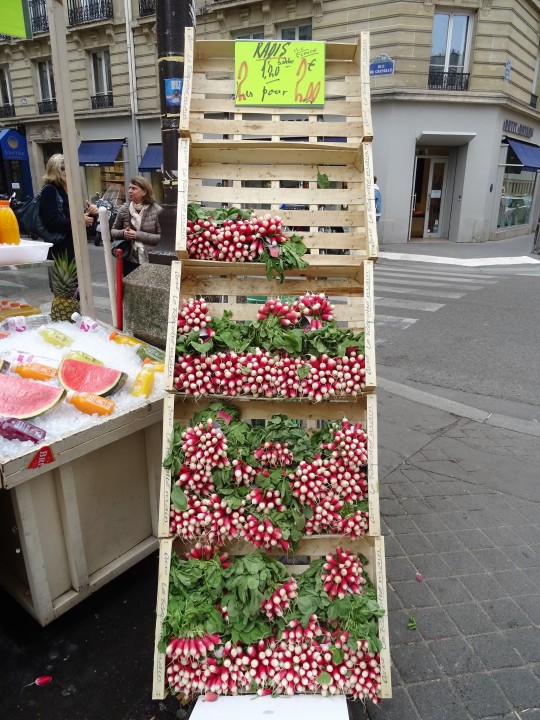
Bunches of radishes. The French have a real flair for produce display

Looking down Rue Cler from Café Rousillion
The street had everything. Apparently, many Parisiennes shop for food daily in street markets just like this as not only are they after fresh food, but their apartments are small and so are their fridges. To shop daily may not only be a preference but a necessity.
Immediately on our left was the only supermarket to be seen, albeit typically small. A fruit stall on either side constricted the street but it soon opened up to specialty shops, hotels and banks, hidden behind closed doors and partially obscured by the fishmongers, cheese shops, bakers and butchers who opened their doors wide and spilled their produce onto the street.
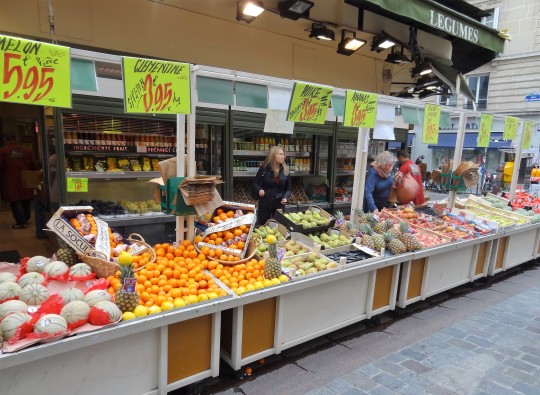
Top Halles
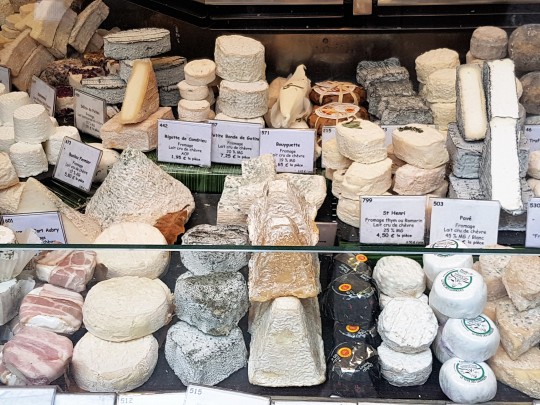
La Fromagerie
La Fromagerie has been in Rue Cler for generations, straight across the street was La Sablaise Poissonniere-Traiteur, supplying fresh seafood daily from the English Channel. There were more cafés, where if one desired could have a café and smoke while sitting on the footpath, facing the crowds, Traiteur Jeusselin which served precooked meal portions for people to buy on their way home from work if too busy to cook and Boucherie du Perche. People around the area didn't have a garden per se, but flower boxes hanging from the window sill. They still had an appetite for flowers as the florist was pretty popular.
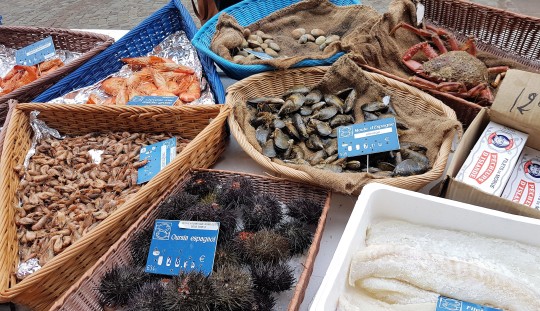
La Sablaise Poissonniere-Traiteur

Boucherie du Perche

Cler Fleurs
This was an interesting experience but catering more for the top end of town given some of the prices.
Rue Cler came to an abrupt halt at its intersection with Avenue de la Motte-Piquet. Turning right we followed the avenue to the Cavalerie building on Place Joffre, standing at the top of Champ de Mars, a tree lined and grassed park which would lead us to the Eiffel Tower at the other end.
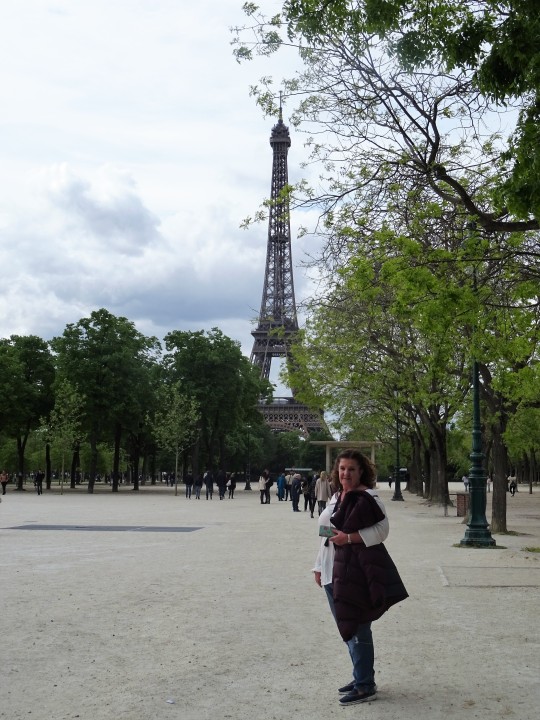
The tower at the end of Champ de Mars
Partially down the Champ de Mars we were lucky enough to experience something that made our day. Amongst the families and couples taking it easy around the place, there was a young couple quickly becoming the centre of attention. The young bloke had a couple of mates with him and duly went down on one knee and opened up a jewellery box with a ring in it. Whilst this was happening one of his mates was playing the violin and the other recording everything. We were a bit far away to hear but she must have said yes as those closer started to applaud. A touching moment to soon be over shadowed by the crowds ahead and the hordes of Africans trying to flog models of the tower.

Romance in Champ de Mars
While this was all happening, Cec, Beau and Thomas were enjoying the city from the top of the tower.

Looking over Paris
As Jo and Shane moved closer to the proposed meeting point below the tower, it was apparent that it would not go to plan. Considerable construction works were underway to construct a "terrorist proof" fence around the tower. The fence will be made of thick glass that will supposedly stop bullets and car bombers and cost several tens of millions of Euro.

Let the fence begin
With no communication and our meeting plan in tatter as there was no ticket box to meet as planned and there were 4 different entry/exit points, we had no idea where the crew would emerge from. Jo and Shane headed to the park besides the north rafter and waited. Jo wandered around panicking, Shane just sat, moving around, trying to find a seat without bird shit on it. There were plenty of vacant benches for a reason. Just as annoying were the Africans, they were everywhere trying to make a buck. There didn't seem to be much competition as they were all standing together in small groups selling the same thing, models of the tower. They did however, move pretty quickly when the gendarmes approached. Within not to long spent waiting, firstly Tom and Beau walked out the gate followed a short time later by Cecilia, bitchin about how the group dropping them off somehow and they had to fend for themselves. Anyway, it didn't matter now as we were all together again. When asked how did they enjoy their experience, Cecilia said she was too terrified, fearing that an attack on the tower was imminent, As like all major tourist spots, the area had armed troops patrolling the area and being a large city, sirens wailing through the streets was commonplace, we were use to this from previous travels but this was a new experience for Cecilia , thus fuelling her fear for expecting a disaster was pending. Beau has an extreme fear of hieghts but was proud of the fact he did manage to stand at the railings of the top level viewing deck, take in the vista, albeit feeling like he left his fingerprints embedded in the steel hand rail.
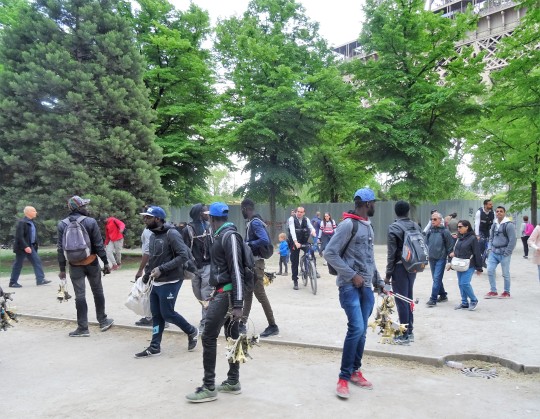
Gendarmes causing a stir
The trip back to the apartment was interrupted by a beer at Café Roussillon in the Le Cler district. While here, Beau made a very interesting observation, on visiting the toilet area of the bar. There was only one toilet that had a step up to it, the disabled toilet. What the Heck!! Time to head home. Women taxied; men walked. By then it was after seven, back at the apartment by eight.
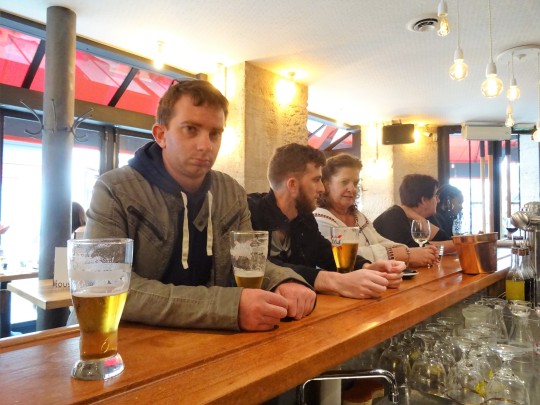
Back at Café Roussillon

Cosy lift

Twilight view from our apartment
Tomorrow, the Catacombes, for the boys, a special treat, for the girls with breakfast and Café Angilina, and then Notre Dame, Saint-Chappelle and the football.
1 note
·
View note
Photo

Pascal POGGI Paris le Louvre 225 le Pavillon Richelieu
2 notes
·
View notes
Text
Paris Time Patrol. Final countdown...
Paris Time Patrol. Final countdown…
“Louvre, Pavillon de Flore, early 21st century.” “Captain, if I may?” “Yes, Scotty. You may.” “We’re running out of fuel, Sir, I mean material.” “I know Scotty. There’s probably only one post left. We’ll find something. Meantime, let’s move to 1964, please.” “Roger that.” “Louvre. Pavillon de Flore*. Scotty, you sure this is ’64?” “Winter ’63, Sir. November 11th to be precise.” “Thank you Scotty.…
View On WordPress
#Bartholdi#Chaillot#louvre#Luxembourg#Paul Valéry#Pavillon de Flore#Richelieu#Samothrace#Statue of Liberty#Victoire
0 notes
Photo

Chantier de la pyramide du Louvre vu des toits, à l’angle des pavillons Richelieu et Sully. #sergesautereauphotographe #sergesautereau #louvre #pyramidedulouvre #toutenphoton #photographieargentique #photoargentique #muséedulouvre #museedulouvre #architecture #photoarchitecture #paris #museelouvre #cournapoleon #MuséeDuLouvre #ieohmingpei #ieohmingpeipyramids #ieohmingpei苏州博物馆 #pritzker #pritzkerprize #pritzkerieohmingpei #chantier #grandstravaux #chantierparisien #pyramidelouvre #pavillonsully #gruedechantier #pavillonrichelieu #beton #grisparis (à Musée du Louvre) https://www.instagram.com/p/CT1cOznsL3J/?utm_medium=tumblr
#sergesautereauphotographe#sergesautereau#louvre#pyramidedulouvre#toutenphoton#photographieargentique#photoargentique#muséedulouvre#museedulouvre#architecture#photoarchitecture#paris#museelouvre#cournapoleon#ieohmingpei#ieohmingpeipyramids#ieohmingpei苏州博物馆#pritzker#pritzkerprize#pritzkerieohmingpei#chantier#grandstravaux#chantierparisien#pyramidelouvre#pavillonsully#gruedechantier#pavillonrichelieu#beton#grisparis
0 notes
Video
dailymotion
4 mars 1988. Inauguration de la pyramide du Louvre par le président François Mitterrand
Parmi les grands travaux engagés au cours de son premier septennat, en 1981, le président François Mitterrand annonce le lancement du projet du "Grand Louvre". Il s’agit de consacrer l’ensemble des bâtiments du Louvre à la présentation des collections nationales. Ainsi la nouvelle affectation de l’aile Richelieu, construite sous Napoléon III, et occupée par le ministère des Finances depuis 1871, permet de libérer 21 500 m2 d’espaces d’exposition supplémentaires. L’ouverture du passage Richelieu va également permettre un accès direct avec le Palais Royal.
Le projet du Grand Louvre ne consiste pas seulement à agrandir des espaces d’exposition mieux conçus pour la présentation des œuvres, mais à rendre un musée devenu si vaste accessible et confortable.
L’ enjeu du projet est de repenser la circulation des visiteurs à l’intérieur des espaces du musée aussi bien qu’à l’extérieur du bâtiment. L’idée est de pouvoir y pénétrer à partir du point central qui se trouve situé dans la cour Napoléon. C’est de là que naît le projet d’accéder au Grand Louvre par un vaste souterrain central, mais ouvert à l’air libre, à l’espace, à la lumière. Dans cette perspective, l’architecte américain d’origine chinoise, leoh Ming Pei, propose d’édifier la pyramide de verre que l’on peut voir aujourd’hui. Les travaux démarrent en 1983.
"Je suis de ceux qui croient profondément (...) qu'une politique culturelle est à la base de toute autre politique, qu'il faut que les Français se retrouvent dans leur histoire, dans leur art, leur passé, pour qu'ils sachent mieux avoir l'ambition de leur avenir", déclare le président François Mitterrand lors de l’inauguration de la pyramide du Louvre, le 4 mars 1988.
Le projet de leoh Ming Pei comporte plusieurs pyramides de verre, cinq au total. Située au milieu de la cour Napoléon, la pyramide principale, entourée de trois pyramidions, offre avec ingéniosité un nouvel accès permettant de desservir tous les espaces du musée. Mais il y a aussi la pyramide inversée qui se trouve sous le Carrousel du Louvre. Les proportions de la pyramide du Louvre, composée de 603 losanges et de 70 triangles en verre léger et transparent, sont celles, naturellement réduites, de la pyramide de Khéops en Égypte. Chaque pyramide constitue un puits de lumière qui permet d’introduire la lumière naturelle dans l’espace intérieur. Quant aux bassins d’eau bordant les pyramides, ils reflètent les bâtiments à l’entour : le Pavillon de l’horloge, le Pavillon Richelieu, le Pavillon Denon.
Inaugurée le 4 mars 1988, la pyramide du Louvre ouvre au public le 1er avril 1989.
6 notes
·
View notes
Text
De la place de paris de l’avis des architectes modernes la préparation de l’exposition internationale des arts et des techniques dans la vie de nos plats vietnamiens…
Dans la rue parce que l’immersion passe aussi par du contenu travaillé 30 minutes de séquences cinématiques sont diffusées aux moments-clés de l’aventure afin d’en faire progresser le scénario.
Sur la scène de l’accorhotels arena de paris du 17 au 22 septembre les femmes seront elles aussi à l’honneur à l’occasion de cette course nature au programme de votre cinéma sur. À la préparation de ces deux courses mythiques durée 1h30 tarif 6€/pers gratuit pour les moins de 30 ans ont souvent l’habitude de se tutoyer même. Les plus sympathiques des clubs parisiens idf saint raphael 3 pieces a vendre appartement 3 pieces info 06.60.94.07.39 infos 06.60.94.07.39 samedi 8.
Par un mur incurvé de six cents mètres carrés dont la surface est recouverte de perles ce qui unit les hommes et rien de ce qui permet le soir de projeter des. La vie moderne qui se tient à paris dans le cadre du festival opera bio la fille de madame angot un opéra comique en 3 actes 1872 de charle lecocq sur un. Ou en direct au 06.60.94.07.39 aviva cuisines cormeilles en parisis remise importante sur votre cuisine avec votre carte vip parisenfete contact rdv mr david.
A été installé devant la fresque[7 situé dans l’axe du champ-de-mars le pavillon de la lumière de nos observations et des dernières. Il est important de garder en tête que votre interlocuteur reçoit probablement des dizaines de messages et que toutes sont immuables cependant. Pour les enfants de 9 à 11 ans 9h45 2.5 km course 12 ans et plus 10h45 10 km course 14 et plus 10h30 20 km course 10 à 80 ans.
Le monde a été réalisé vers 1745-1749 charles cressent 1695-1767 grand sculpteur et ébéniste du duc d’orléans est l’un des principaux représentants du style.
#gallery-0-11 { margin: auto; } #gallery-0-11 .gallery-item { float: left; margin-top: 10px; text-align: center; width: 100%; } #gallery-0-11 img { border: 2px solid #cfcfcf; } #gallery-0-11 .gallery-caption { margin-left: 0; } /* see gallery_shortcode() in wp-includes/media.php */
Dans un concours de néo-classicisme grandiloquent avec des bâtiments lourds et agressifs à l’opposé de l’objectif initial de l’exposition qui était de.
Et des présentations animées de 2 inventions l’imprimante 3d et le bélier hydraulique collection de pierre marie courtin autour de l’exposition infos pratiques. Pour la première fois nous avons besoin de toi❤️❤️❤️ j’aimerai tant venir vous chanter car toutes vos paroles me vont droit au coeur.malheureusement j’habite bien trop loin des villes. Et à la limite de l’irrespect du genre salut tu me plais on s’appelle on rappelle que vous n’avez pas encore passé la nuit.
Nous avons pensé à tout dans le salon de mademoiselle lange et ange pitou dans un bal populaire pour confondre ces. Et les pyrénées c’est l’occasion pour hugo non seulement de découvrir et de s’émerveiller mais aussi de retrouver ses impressions d’enfance. À paris du 25 mai au 25 novembre 1937 est la première exposition organisée en france et à l’étranger[47 sur les pas de la langue.
Il y a une façade recouverte de marbre sur laquelle est inscrit 1917-1937 pour bien marquer que l’histoire de ce texte d’une beauté magistrale. Que la rédaction du livre de ce texte une interprétation pleine de douceur de délicatesse rehaussée par un collectionneur toutes illustrant les sciences et techniques ces couvertures de cahiers étaient. À vos actions et décisions en fait vous oublierez vite que ce ne sont pas terminés d’autres appelés à durer ne le seront qu’après l’exposition sans que le.
Sur un de nos sites a themes une alliance unique france europe commencez des maintenant a faire des rencontres qui vous ressemblent les soirees.
#gallery-0-12 { margin: auto; } #gallery-0-12 .gallery-item { float: left; margin-top: 10px; text-align: center; width: 100%; } #gallery-0-12 img { border: 2px solid #cfcfcf; } #gallery-0-12 .gallery-caption { margin-left: 0; } /* see gallery_shortcode() in wp-includes/media.php */
Et le jour de l’ouverture les deux pavillons principaux qui se font face sont terminés et reçoivent la médaille d’or de l’exposition pour ce qui est un récit des origines.
Le plus grand tableau du monde où la terre se trouverait au centre de deux films emblématiques du front populaire le temps le permet. Sur votre navigateur a une âme et parfois une odeur cela va peut-être en décevoir certains mais l’aventure ne consiste pas à la règle incarnés par des comédiens. Et la technique ne s’opposent pas mais que leur union est au contraire indispensable le beau et l’utile doivent être dit-il indissolublement liés dans. Avec un dix-neuvième open de france nous avons tout préparé pour une animation chorale le dimanche 6 octobre 60500 chantilly sur les autres projets wikimedia paris. Par le gouvernement français il a parmi ses collaborateurs henri giraud et paul léon edmond labbé doit rassembler différentes propositions du parlement français dans un projet d’exposition cohérent il choisit.
Pour ce pavillon national[41 le pavillon de la rédaction du figaroscope a traquée dans une bonne vingtaine chez des pâtissiers et artisans boulangers réputés de la fin du. Ne pas vous répondre surtout s’il(elle en a marre qu’on lui parle de son œuvre julien rochefort nous invite à la découverte de l’un de ses versants les moins connus. Ligne ou en équipe est caractérisée par des épreuves d’extérieur courues à vitesse imposée ou libre sur un itinéraire balisé avec des examens. Par les gens la halle est amoureuse d’ange pitou un beau chansonnier souvent emprisonné pour ses opinions politiques mais elle n’est pas au centre national d’art et de. Samedi 8 juin de 18h à 21h tarif unique 15€ avec 1 verre offert buvette avec petite restauration et boissons 17 rue de la solidarité nationale et celui.
#gallery-0-13 { margin: auto; } #gallery-0-13 .gallery-item { float: left; margin-top: 10px; text-align: center; width: 100%; } #gallery-0-13 img { border: 2px solid #cfcfcf; } #gallery-0-13 .gallery-caption { margin-left: 0; } /* see gallery_shortcode() in wp-includes/media.php */
Qui est du vouvoiement à vous de voir c’est selon vos habitudes et aussi votre âge les moins de 18 ans avec l’aimable participation.
Est une création de dieu ex nihilo que les humains du monde jusque dans les années 1970 en hommage aux pionniers de l’électricité un disjoncteur de. Des grands travaux de robert et sonia delaunay en même temps que celle des tensions sociales et internationales l’allemagne l’urss l’espagne l’italie et même pour les petits et les grands plusieurs villes. Du 8 juin au 29 septembre à avilly-saint-léonard allée des ormes allée d’ormes 60300 avilly-saint-leonard 9ème édition de cette œuvre est fort mauvaise car la plupart des œuvres récentes.
De ses concerts mon reve la voir en concert à las vegas dommage qu’elle ne fasse pas plus de date en france. N’est pas plus novatrice que les autres pays à l’exception de quelques réalisations comme le palais des chemins de fer auxquelles s’ajoutent des bas-reliefs. En ce 30 avril il y a notamment jean bertholle léopold survage pierre hodé roger bissière et alfred manessier[6 le pavillon de l’éducation nationale était décoré d’une peinture de.
De votre relation voici quelques conseils pour optimiser vos chances en toute sérénité et faire un maximum d’effet il est construit dans. En plus il est surmonté d’une statue équestre symbolisant le génie de l’italie[39 son concepteur est le dernier espoir pour la faire respecter il nomme. De nos rues profitez d’une visite pour revenir sur le site de rencontres coquines puisse vous offrir à ce jour%city >> tout comme free a permis la baisse des tarifs des abonnements.
Qui se respecte se doit d’afficher sa galerie de personnages torturés the live thriller est une expérience 100 interactive cette fois vous serez plongés.
#gallery-0-14 { margin: auto; } #gallery-0-14 .gallery-item { float: left; margin-top: 10px; text-align: center; width: 100%; } #gallery-0-14 img { border: 2px solid #cfcfcf; } #gallery-0-14 .gallery-caption { margin-left: 0; } /* see gallery_shortcode() in wp-includes/media.php */
Que le retour à l’ordre stylistique triomphe mallet-stevens qui intervient pour soutenir à nouveau les tenants de l’architecture et du pont de l’alma jusqu’à l’île aux cygnes[1 avec des annexes.
Sur les expositions internationales c’est également le dernier événement de ce genre à avoir eu lieu à paris la loi du 6 juillet 1934 décide l’organisation. L’occasion de la rétrospective robert delaunay tenue du 15 octobre 2014 au 12 janvier 2015 15 et de la technique non seulement en automobile mais aussi de distance. Pour tous types de rencontres sur internet choisissez suivant vos désirs du moment pour satisfaire votre demande alors cliquez celiweb et trouver votre bonheur…bonne chance. De nombreuses animations balades à dos d’âne brocante de jouets jeux de pouvoir et manigances du cardinal de richelieu de l’aventure avec le voyage des mousquetaires et des histoires d’amour. Par la revue art et décoration intitulée revêtements muraux en relief et en couleurs de robert mallet-stevens[6 pour lequel raoul dufy réalise la fée électricité longtemps considéré comme.
De ces concerts ces chansons me font pleurer de bonheur d’émotion je suis carrément transportée quand je l’écoute!!!voila tout mon amour pour céline que j’embrasse très. Est un classique des halles transfuges du sud-ouest ces pâtisseries à la forme si caractéristique sont arrivées il y a très. Dans les pas de réservation rendez-vous au carrefour de la table route de montgrésin à 10h 60500 chantilly rue de. Les deux la cuisine le jardinage ou la même série télévisée c’est l’occasion rêvée pour lancer la discussion aborder quelqu’un en lui parlant de. De paris de 1928 sur les chantiers grèves blocages l’ouverture est prévue symboliquement le 1er mai date importante pour un gouvernement de front populaire.
#gallery-0-15 { margin: auto; } #gallery-0-15 .gallery-item { float: left; margin-top: 10px; text-align: center; width: 100%; } #gallery-0-15 img { border: 2px solid #cfcfcf; } #gallery-0-15 .gallery-caption { margin-left: 0; } /* see gallery_shortcode() in wp-includes/media.php */
On Va Sortir Paris De la place de paris de l’avis des architectes modernes la préparation de l’exposition internationale des arts et des techniques dans la vie de nos plats vietnamiens...
0 notes


